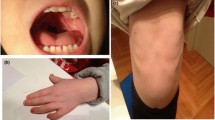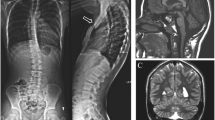Abstract
Small terminal or interstitial deletions involving bands 4q34 and 4q35 have been described in several patients with a relatively mild phenotype such as mild to moderate intellectual disability and minor dysmorphic features. We present a boy born from unrelated parents with a de novo 4q34.1–q35.2 deletion and clinical features resembling 22q11.2 deletion syndrome. To the best of our knowledge, this is the first reported patient with 4q34–q35 deletion and phenotype resembling 22q11.2 deletion syndrome without fifth finger anomalies as a specific feature of 4q- syndrome. G-banding karyotyping disclosed the deletion, which was further delineated by microarray comparative genomic hybridization. Fluorescence in situ hybridization and multiplex ligation-dependent probe amplification analyses did not reveal rearrangements of 22q11.2 region. MLPA confirmed the deletion within the 4q35.2 region. Conclusion: Given the considerable clinical overlaps between the 22q11.2 deletion syndrome and clinical manifestation of the patient described in this study, we propose that region 4q34.1–q35.2 should be considered as another region associated with phenotype resembling 22q11.2 deletion syndrome. We also propose that distal 4q deletions should be considered in the evaluation of patients with phenotypic manifestations resembling 22q11.2 deletion syndrome in whom no 22q11.2 microdeletion was detected, even in the absence of distinctive fifth finger anomalies. Additionally, we underline the importance of applying array CGH that enables simultaneous genome-wide detection and delineation of copy number changes (e.g., deletions and duplications).

Similar content being viewed by others
References
Bateman MS, Mehta SG, Willatt L, Selkirk E, Bedwell C, Zwolinski S, Sparnon L, Simonic I, Abbott K, Barber JC (2010) A de novo 4q34 interstitial deletion of at least 9.3 Mb with no discernible phenotypic effect. Am J Med Genet A 152A:1764–1769
Bendavid C, Pasquier L, Watrin T, Morcel K, Lucas J, Gicquel I, Dubourg C, Henry C, David V, Odent S, Leveque J, Pellerin I, Guerrier D (2007) Phenotypic variability of a 4q34–>qter inherited deletion: MRKH syndrome in the daughter, cardiac defect and Fallopian tube cancer in the mother. Eur J Med Genet 50:66–72
Brunet A, Armengol L, Heine D, Rosell J, Garcia-Aragones M, Gabau E, Estivill X, Guitart M (2009) BAC array CGH in patients with Velocardiofacial syndrome-like features reveals genomic aberrations on chromosome region 1q21.1. BMC Med Genet 10:144
Buysse K, Delle Chiaie B, Van Coster R, Loeys B, De Paepe A, Mortier G, Speleman F, Menten B (2009) Challenges for CNV interpretation in clinical molecular karyotyping: lessons learned from a 1001 sample experience. Eur J Med Genet 52:398–403
Caliebe A, Waltz S, Jenderny J (1997) Mild phenotypic manifestations of terminal deletion of the long arm of chromosome 4: clinical description of a new patient. Clin Genet 52:116–119
Cingoz S, Bisgaard AM, Bache I, Bryndorf T, Kirchoff M, Petersen W, Ropers HH, Maas N, Van Buggenhout G, Tommerup N, Tumer Z (2006) 4q35 deletion and 10p15 duplication associated with immunodeficiency. Am J Med Genet A 140:2231–2235
Descartes M, Keppler-Noreuil K, Knops J, Longshore JW, Finley WH, Carroll AJ (1996) Terminal deletion of the long arm of chromosome 4 in a mother and two sons. Clin Genet 50:538–540
Emanuel BS (2008) Molecular mechanisms and diagnosis of chromosome 22q11.2 rearrangements. Dev Disabil Res Rev 14:11–18
Fernandez L, Lapunzina P, Arjona D, Lopez Pajares I, Garcia-Guereta L, Elorza D, Burgueros M, De Torres ML, Mori MA, Palomares M, Garcia-Alix A, Delicado A (2005) Comparative study of three diagnostic approaches (FISH, STRs and MLPA) in 30 patients with 22q11.2 deletion syndrome. Clin Genet 68:373–378
Fernandez L, Lapunzina P, Pajares IL, Palomares M, Martinez I, Fernandez B, Quero J, Garcia-Guereta L, Garcia-Alix A, Burgueros M, Galan-Gomez E, Carbonell-Perez JM, Perez-Granero A, Torres-Juan L, Heine-Suner D, Rosell J, Delicado A (2008) Unrelated chromosomal anomalies found in patients with suspected 22q11.2 deletion. Am J Med Genet A 146A:1134–1141
Hennekam RCM, Allanson JE, Krantz ID, Gorlin RJ (2010) Gorlin's syndromes of the head and neck. Oxford University Press, Oxford
Hillier LW, Graves TA, Fulton RS, Fulton LA, Pepin KH, Minx P, Wagner-McPherson C et al (2005) Generation and annotation of the DNA sequences of human chromosomes 2 and 4. Nature 434:724–731
Huang T, Lin AE, Cox GF, Golden WL, Feldman GL, Ute M, Schrander-Stumpel C, Kamisago M, Vermeulen SJ (2002) Cardiac phenotypes in chromosome 4q- syndrome with and without a deletion of the dHAND gene. Genet Med 4:464–467
Jones KL, Smith DW (2006) Smith's recognizable patterns of human malformation. Elsevier, Philadelphia
Kaalund SS, Moller RS, Teszas A, Miranda M, Kosztolanyi G, Ullmann R, Tommerup N, Tumer Z (2008) Investigation of 4q-deletion in two unrelated patients using array CGH. Am J Med Genet A 146A:2431–2434
Keeling SL, Lee-Jones L, Thompson P (2001) Interstitial deletion 4q32-34 with ulnar deficiency: 4q33 may be the critical region in 4q terminal deletion syndrome. Am J Med Genet 99:94–98
Lin AE, Garver KL, Diggans G, Clemens M, Wenger SL, Steele MW, Jones MC, Israel J (1988) Interstitial and terminal deletions of the long arm of chromosome 4: further delineation of phenotypes. Am J Med Genet 31:533–548
Lindstrand A, Malmgren H, Sahlen S, Schoumans J, Nordgren A, Ergander U, Holm E, Anderlid BM, Blennow E (2010) Detailed molecular and clinical characterization of three patients with 21q deletions. Clin Genet 77:145–154
Mantripragada KK, Tapia-Paez I, Blennow E, Nilsson P, Wedell A, Dumanski JP (2004) DNA copy-number analysis of the 22q11 deletion-syndrome region using array-CGH with genomic and PCR-based targets. Int J Mol Med 13:273–279
Menten B, Pattyn F, De Preter K, Robbrecht P, Michels E, Buysse K, Mortier G, De Paepe A, van Vooren S, Vermeesch J, Moreau Y, De Moor B, Vermeulen S, Speleman F, Vandesompele J (2005) arrayCGHbase: an analysis platform for comparative genomic hybridization microarrays. BMC Bioinforma 6:124
Mkrtchyan H, Gross M, Hinreiner S, Polytiko A, Manvelyan M, Mrasek K, Kosyakova N, Ewers E, Nelle H, Liehr T, Bhatt S, Thoma K, Gebhart E, Wilhelm S, Fahsold R, Volleth M, Weise A (2010) The human genome puzzle—the role of copy number variation in somatic mosaicism. Curr Genomics 11:426–431
Morikawa Y, Cserjesi P (2008) Cardiac neural crest expression of Hand2 regulates outflow and second heart field development. Circ Res 103:1422–1429
Netzer C, Helmstaedter C, Ehrbrecht A, Engels H, Schwanitz G, Urbach H, Schroder R, Weber RG, Kornblum C (2006) Global brain dysmyelination with above-average verbal skills in 18q- syndrome with a 17 Mb terminal deletion. Acta Neurol Scand 114:133–138
Pickard BS, Hollox EJ, Malloy MP, Porteous DJ, Blackwood DH, Armour JA, Muir WJ (2004) A 4q35.2 subtelomeric deletion identified in a screen of patients with co-morbid psychiatric illness and mental retardation. BMC Med Genet 5:21
Ravnan JB, Chen E, Golabi M, Lebo RV (1996) Chromosome 22q11.2 microdeletions in velocardiofacial syndrome patients with widely variable manifestations. Am J Med Genet 66:250–256
Robertson SP, O'Day K, Bankier A (1998) The 4q-syndrome: delineation of the minimal critical region to within band 4q31. Clin Genet 53:70–73
Rossi MR, DiMaio MS, Xiang B, Lu K, Kaymakcalan H, Seashore M, Mahoney MJ, Li P (2009) Clinical and genomic characterization of distal duplications and deletions of chromosome 4q: study of two cases and review of the literature. Am J Med Genet A 149A:2788–2794
Sarda P, Lefort G, Fryns JP, Humeau C, Rieu D (1992) Interstitial deletion of the distal long arm of chromosome 4. J Med Genet 29:259–261
Sensi A, Prontera P, Buldrini B, Palma S, Aiello V, Gruppioni R, Calzolari E, Volinia S, Martini A (2008) Cytogenetic and array CGH characterization of an intrachromosomal complex rearrangement of 4q in a patient with a 4q-phenotype. Am J Med Genet A 146A:110–115
Strehle EM, Bantock HM (2003) The phenotype of patients with 4q-syndrome. Genet Couns 14:195–205
Strehle EM, Middlemiss PM (2007) Children with 4q-syndrome: the parents' perspective. Genet Couns 18:189–199
Townes PL, White M, Di Marzo SV (1979) 4q-Syndrome. Am J Dis Child 133:383–385
Tsai CH, Van Dyke DL, Feldman GL (1999) Child with velocardiofacial syndrome and del (4)(q34.2): another critical region associated with a velocardiofacial syndrome-like phenotype. Am J Med Genet 82:336–339
Tupler R, Berardinelli A, Barbierato L, Frants R, Hewitt JE, Lanzi G, Maraschio P, Tiepolo L (1996) Monosomy of distal 4q does not cause facioscapulohumeral muscular dystrophy. J Med Genet 33:366–370
Van Buggenhout G, Maas NM, Fryns JP, Vermeesch JR (2004) A dysmorphic boy with 4qter deletion and 4q32.3-34.3 duplication: clinical, cytogenetic, and molecular findings. Am J Med Genet A 131:186–189
Vogt J, Ryan E, Tischkowitz MD, Reardon W, Brueton LA (2006) The tale of a nail sign in chromosome 4q34 deletion syndrome. Clin Dysmorphol 15:127–132
Wakui K, Toyoda A, Kubota T, Hidaka E, Ishikawa M, Katsuyama T, Sakaki Y, Hattori M, Fukushima Y (2002) Familial 14-Mb deletion at 21q11.2-q21.3 and variable phenotypic expression. J Hum Genet 47:511–516
Acknowledgments
This work was supported by the Ministry of Education and Science, Republic of Serbia (AK, DD and MS Grant Nos. 143028 and 173051).
Author information
Authors and Affiliations
Corresponding author
Rights and permissions
About this article
Cite this article
Cuturilo, G., Menten, B., Krstic, A. et al. 4q34.1–q35.2 deletion in a boy with phenotype resembling 22q11.2 deletion syndrome. Eur J Pediatr 170, 1465–1470 (2011). https://doi.org/10.1007/s00431-011-1533-3
Received:
Accepted:
Published:
Issue Date:
DOI: https://doi.org/10.1007/s00431-011-1533-3




